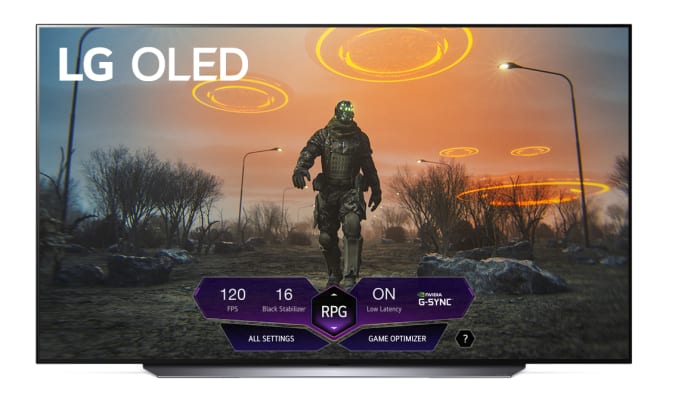LG’s OLED TVs have gone further than all their rivals over the past couple of years to accommodate both current and next-gen gamers. Key features such as support for variable refresh rates, Nvidia G-Sync, automatic low latency mode switching and 4K resolution graphics at frame rates up to 120Hz have been the order of the day since 2019.
Even the best intentions don’t always pan out perfectly, though. So it is that gaming owners of LG’s 2019 and 2020 OLED TVs have become aware of a couple of problems with their TVs’ variable refresh rate implementation.
The biggest issue, and one that affects both 2019 and 2020 LG OLED sets, is that when VRR is activated, the image undergoes a brightness/gamma shift that makes dark areas in games look greyer and more washed out than they do with VRR turned off. I’ve seen this for myself recently on an LG OLED48CX.

LG OLEDs like this OLED77GX are packed with next-gen gaming features. It turns out there's currently ... [+]
Photo: LG ElectronicsSo, for instance, toggling the AMD Freesync feature in the LG OLED TVs’ menus on and off with the Gears 5 HDR calibration screen playing shows that with the VRR feature on, the black floor is raised and, as a result, there’s less visible shading detail in the dark areas of the left side of the Gears 5 calibration image.
The issue is particularly noticeable if you turn off the TVs’ instant game response feature and switch to a picture preset other than Game (Standard probably reveals then gamma shift most clearly).
The other issue some are reporting - and have captured on video - is noticeable instability/flickering in some dark gaming image areas when using VRR modes on LG’s 2019 OLEDs.
I fed examples of these problems back to LG a while back, and they’ve come back to me with what can probably best be described as good news and bad news.
The good news is that LG now formally acknowledges that the issues exist, having apparently been able to replicate them in their own labs thanks to the efforts of various individuals who sent me videos, photos and clear examples of where the problems occur that I could pass on to LG’s engineers. And now that these engineers acknowledge that the issues exist, they’ve actively embarked on looking for a solution.
The bad news is that it appears from their initial investigations that finding a solution is not going to be straightforward, and so could take some time.
LG has promised to let me know when it has something positive to report. But in the meantime it has given me this official statement to share:
“LG Electronics is aware there can be situations when luminance changes in dark scenes with gaming content in VRR mode. The changes may look more visible than they are on LCD panel devices because the OLED black is basically deeper, which makes brightness differences seen to the eyes in the low grey area appear greater. As an early adopter of VRR in the TV market, despite the challenges of implementing advanced gaming features in the current panel technology, we always look to best integrate new technology and improve the experience for our customers.”
Naturally I’ll post any further updates on my Forbes channel if and when I hear anything.
—
If you found this article interesting you might also like these:
LG Announces First OLED TVs With Nvidia Geforce RTX 30 Series Support
LG OLED77GX OLED TV Review: Theater Of Dreams
Yamaha Unveils The Most PS5 And Xbox Series X-Friendly AV Receivers Yet
Vizio TVs Push PS5 And Xb0x Series X Credentials With ‘Marvel’s Avengers’ Deal
The Link LonkSeptember 03, 2020 at 03:31AM
https://ift.tt/31PzDUy
LG Acknowledges OLED TV VRR Issues - But Can’t Promise A Quick Fix - Forbes
https://ift.tt/3eaxdmA
LG

No comments:
Post a Comment